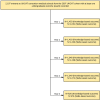What is the effect of secondary (high) schooling on subsequent medical school performance? A national, UK-based, cohort study
- PMID: 29792300
- PMCID: PMC5988088
- DOI: 10.1136/bmjopen-2017-020291
What is the effect of secondary (high) schooling on subsequent medical school performance? A national, UK-based, cohort study
Abstract
Objectives: University academic achievement may be inversely related to the performance of the secondary (high) school an entrant attended. Indeed, some medical schools already offer 'grade discounts' to applicants from less well-performing schools. However, evidence to guide such policies is lacking. In this study, we analyse a national dataset in order to understand the relationship between the two main predictors of medical school admission in the UK (prior educational attainment (PEA) and performance on the United Kingdom Clinical Aptitude Test (UKCAT)) and subsequent undergraduate knowledge and skills-related outcomes analysed separately.
Methods: The study was based on national selection data and linked medical school outcomes for knowledge and skills-based tests during the first five years of medical school. UKCAT scores and PEA grades were available for 2107 students enrolled at 18 medical schools. Models were developed to investigate the potential mediating role played by a student's previous secondary school's performance. Multilevel models were created to explore the influence of students' secondary schools on undergraduate achievement in medical school.
Results: The ability of the UKCAT scores to predict undergraduate academic performance was significantly mediated by PEA in all five years of medical school. Undergraduate achievement was inversely related to secondary school-level performance. This effect waned over time and was less marked for skills, compared with undergraduate knowledge-based outcomes. Thus, the predictive value of secondary school grades was generally dependent on the secondary school in which they were obtained.
Conclusions: The UKCAT scores added some value, above and beyond secondary school achievement, in predicting undergraduate performance, especially in the later years of study. Importantly, the findings suggest that the academic entry criteria should be relaxed for candidates applying from the least well performing secondary schools. In the UK, this would translate into a decrease of approximately one to two A-level grades.
© Article author(s) (or their employer(s) unless otherwise stated in the text of the article) 2018. All rights reserved. No commercial use is permitted unless otherwise expressly granted.
Conflict of interest statement
Competing interests: LMM is supported in his PhD project via funding from the UKCAT Board and has received travel expenses incurred for attending a UKCAT Research Group meeting. PAT has previously received research funding from the Economic and Social Research Council (ESRC), the Engineering and Physical Sciences Council (EPSRC), the Department of Health for England, the UKCAT Board and the General Medical Council (GMC). In addition, PAT has previously performed consultancy work on behalf of his employing University for the UKCAT Board and Work Psychology Group and has received travel and subsistence expenses for attendance at the UKCAT Research Group.
Figures





Similar articles
-
Predictive validity of the UKCAT for medical school undergraduate performance: a national prospective cohort study.BMC Med. 2016 Sep 26;14(1):140. doi: 10.1186/s12916-016-0682-7. BMC Med. 2016. PMID: 27638740 Free PMC article.
-
The UKCAT-12 study: educational attainment, aptitude test performance, demographic and socio-economic contextual factors as predictors of first year outcome in a cross-sectional collaborative study of 12 UK medical schools.BMC Med. 2013 Nov 14;11:244. doi: 10.1186/1741-7015-11-244. BMC Med. 2013. PMID: 24229380 Free PMC article.
-
Predictors of professional behaviour and academic outcomes in a UK medical school: A longitudinal cohort study.Med Teach. 2015;37(9):868-80. doi: 10.3109/0142159X.2015.1009023. Epub 2015 Feb 10. Med Teach. 2015. PMID: 25665628
-
Does the UKCAT predict performance in medical and dental school? A systematic review.BMJ Open. 2021 Jan 22;11(1):e040128. doi: 10.1136/bmjopen-2020-040128. BMJ Open. 2021. PMID: 33483439 Free PMC article.
-
Insights into undergraduate medical student selection tools: a systematic review and meta-analysis.J Educ Eval Health Prof. 2024;21:22. doi: 10.3352/jeehp.2024.21.22. Epub 2024 Sep 12. J Educ Eval Health Prof. 2024. PMID: 39260821 Free PMC article.
Cited by
-
Can achievement at medical admission tests predict future performance in postgraduate clinical assessments? A UK-based national cohort study.BMJ Open. 2022 Feb 8;12(2):e056129. doi: 10.1136/bmjopen-2021-056129. BMJ Open. 2022. PMID: 35135776 Free PMC article.
-
'Attorneys of the poor': Training physicians to tackle health inequalities.Future Healthc J. 2021 Mar;8(1):12-18. doi: 10.7861/fhj.2020-0242. Future Healthc J. 2021. PMID: 33791453 Free PMC article.
-
Choice of medicine program: A single-institution study.Ann Med Surg (Lond). 2022 Sep 2;81:104410. doi: 10.1016/j.amsu.2022.104410. eCollection 2022 Sep. Ann Med Surg (Lond). 2022. PMID: 36147114 Free PMC article.
-
The role of private education in the selection of primary care careers in low and middle-income countries. Findings from a representative survey of medical residents in Brazil.Hum Resour Health. 2020 Feb 17;18(1):11. doi: 10.1186/s12960-020-0456-3. Hum Resour Health. 2020. PMID: 32066457 Free PMC article.
-
Socio-demographic profile of medical students in Aotearoa, New Zealand (2016-2020): a nationwide cross-sectional study.BMJ Open. 2023 Dec 7;13(12):e073996. doi: 10.1136/bmjopen-2023-073996. BMJ Open. 2023. PMID: 38149418 Free PMC article.
References
-
- Medical School Council. Selecting for excellence final report. 2014. https://www.medschools.ac.uk/media/1203/selecting-for-excellence-final-r... (accessed 3 Mar2017).
-
- McManus IC, Dewberry C, Nicholson S, et al. . The UKCAT-12 study: educational attainment, aptitude test performance, demographic and socio-economic contextual factors as predictors of first year outcome in a cross-sectional collaborative study of 12 UK medical schools. BMC Med 2013;11:244 10.1186/1741-7015-11-244 - DOI - PMC - PubMed
-
- United Kingdom Clinical Aptitude Test (UKCAT) Consortium. UKCAT annual report. 2007. https://www.ukcat.ac.uk/media/1135/annual-report-2007-2008.pdf (accessed 9 Sep 2017).
-
- Association of American Medical Colleges (AAMC). About the medical college aptitude test. 2017. https://students-residents.aamc.org/applying-medical-school/taking-mcat-... (accessed 6 Jun 2017).
Publication types
MeSH terms
Grants and funding
LinkOut - more resources
Full Text Sources
Other Literature Sources
